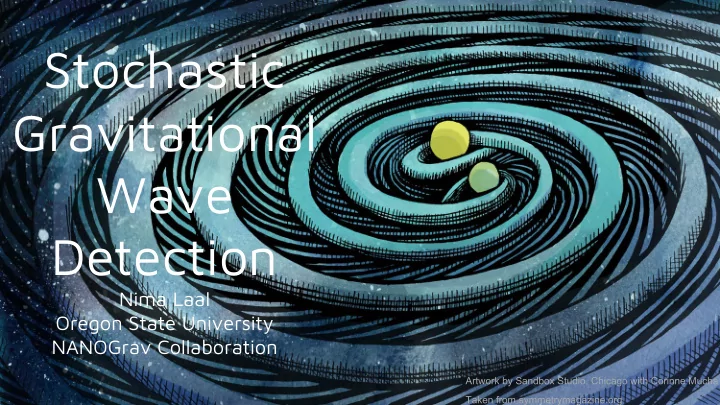

Stochastic Gravitational Wave Detection Nima Laal Oregon State University NANOGrav Collaboration Artwork by Sandbox Studio, Chicago with Corinne Mucha Taken from symmetrymagazine.org
Stochastic ● Sources are: ○ isotropic Gravitational Wave ○ independent ○ point-like Background (SGWB) ○ many ○ far away ● Gravitational waves from such sources correlate photons’ geodesics. Pulsar Timing Array (PTA) is used to observe the correlations. Animation by R. Hurt - Caltech / JPL
Credit: NASA/DOE/Fermi LAT Collaboration via Nature
Stochastic gravitational wave The Problem of behaves like noise in a PTA data set; however, it is not the Detection only source of noise. So, how to tell if a noise is SGWB?
You look for this Hellings and Downs curve, which is hard to extract from a PTA data, but it is THE definite proof for existence of SGWB.
The easiest way to distinguish noises from each other is through their power spectral density. The First Step: The Powerlaw Model: Noise Analysis Spectral index Frequency Power Amplitude Reference Frequency
● The most common colored noises in a PTA data set are: Colored Noise ○ Red: any noise with positive spectral index Terminology ○ White: any noise with zero spectral index
All surviving signals are assumed to A Toy Model be random noises following a powerlaw spectral density model with SGWB noise having a spectral A pulsar with only one white, index of ! = 13/3 (red noise). one red, and one SGWB component and all deterministic signals removed
White noise dominates at Red noise could dominate at low high frequencies frequencies Data = GW + Red Noise + White Noise
You see the problem? Not only the “SGWB” is weak, it is also hidden by high white noise signal. In addition, it is not deterministic!
● SGWB is Red, and that is a problem! ● Deterministic signals need to be removed ○ spin down period, ephemeris In reality… variation, pulsar sky location variation, equipment change,… ● Stochastic signals need to be understood and well modeled ○ SGWB, receiver noise, clock noise, interstellar medium fluctuations, … ● Our models become computationally expensive
● We simply wait long enough (so far 15 years) for the red noises to dominate the white noises (at least in low frequencies) So, how do we do ● We focus more on the lower frequency bins of our data. the noise analysis? ● While waiting, we constantly improve the effectiveness of our Bayesian models in detecting any trace of a Red noise process that can potentially be a SGWB.
We Detect! Credit: NANOGrav 11 Year and 12.5 Year (draft) papers
Recommend
More recommend